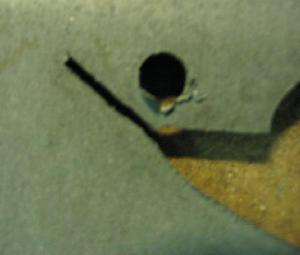Now that I have had the body panels for this car chemically cleaned I am able to see some details on the front fenders which are rather unusual and not evident on later versions.
THE FENDER VENT CUT OUTS
First is the strange way that the vent holes have been manufactured (that’s if you do actually “manufacture” a hole).
This is how they looked before cleaning.
The first thing that is odd are the little cuts at either end of the vent hole. This is what one looks like close up from the inside.
My first thought was that there had been cracks at the ends of the cutouts and someone had run a small saw down the crack and “stop drilled” it but that just does not make sense.
- I have never seen cracks appear at the cutouts on a BN1 or BN2 fender and considering that this is a low mileage car that’s pretty unlikely.
- The cuts are almost the same on both fenders and only one, the rear one in both cases is “stop drilled”.
- On one of the cuts, unfortunately the photo is not good enough to show, the cut runs for about 1/2″ then does an abrupt 30 degree turn before continuing another 1/2″. Try doing that with a hacksaw!!
- As can be seen in the detail picture the cut edge of the cuts, and for that matter the entire cutout, is quite rough with shards remaining in many spots.
It is almost as though the holes were cut out using a primitive water jet system….but in 1953!!! And, if they were using some sort of cutting tool, it looks as though they started at a drilled hole and then moved in to the area to be cut….why not start inside the line?
Anyone got any idea of the tooling or technique used to make these cutouts?
THREE PIECE FENDERS
The other oddity is the construction of the fenders themselves. Each has been made from 3 separate pressings.
There is a weld running vertically at the top of the wheel well.
and another, also running radially near the bottom of the headlight.
These welds are some of the finest production ‘”butt hammer welds I have ever seen!!
I surmise that the manufacturers were still developing their manufacturing techniques and, although rather labour intensive, this is one system that they considered using.
Anyone else come across BN1 fenders made this way?
Added 3 July 2012
Since the original posting of this article we have had the opportunity to study these fenders in more detail and found yet another interesting feature.
Unlike all other Healey fenders that I have ever seen the very bottom of the fender where the metal is bent in to meet up with the inner sill these fenders have a separate piece of metal. This metal is attached with a spot welded lap joint…a real rust trap!!

Although the bottom of the right front fender was rusted and and badly repaired the original lap joint was still evident.
The photo below shows a detail of the rear of the lap joint as viewed from the inside.

The next interesting item is a part of a photograph that I received of Healey 100 #384.

You have to look closely but it has the same odd cuts that #174 has at the ends of the vent cutouts!!
And, while we are on the subject of fenders, this photo is of the dog leg area of the right rear fender from #174.

The left fender’s dog leg area is exactly the same shape as the template.. The right must have been a Friday Fender.






Kent B
I have Healey 291 now restoring
and found the same cuts you did in flash slots on both front fenders?
This has to have happened at factory
Michael S.
did you ever hear of Austin-healy using tungsten steel for fenders, doors, hoods etc.?
general quiery, chuck
Not that I have ever heard of Chuck. Regular carbon steel on everything other than the 100S and pre production cars which were aluminum.
Hello Michael,
Seems the wings are in aluminium, is this correct? My car has steel doors and fenders but it has been in a crash and received some replacement body panels. Pretty sure about the steel doors though. What doors did 174 have?
Some years ago I obtain an old aluminium wing in pretty bad condition which had cracks in the same places but strangely enough the chromium plated decorative ornament hidding the vent was not in Zamak (or whatever you call it) but solid chromium plated bronze, very heavy causing the cracks.
Erik
Hi Eric,
#174 has steel wings and doors and aluminium bonnet and boot lids. The doors on #174 are interesting in that the spacing of the lower screws of the lower hinge are closer together than the uppers. this was not the case on later cars but i’m working on #793 also at present and the spacing of those screws is the same as #174.
Very interesting about the aluminium wing. the ones on #174 are steel and I’m pretty sure that the “cracks” are actually cuts from the manufacturing process.
Michael S
Mihael, I am just wondering if these slits would have been cut to relieve pressure when doing the bodywork on the fenders, like assembling and welding the pieces shown in other photos. Although it is difficult to say without seeing the whole fender, perhaps on some they had to make cuts to relieve the pressure caused by distortion, just a thought.
Jean